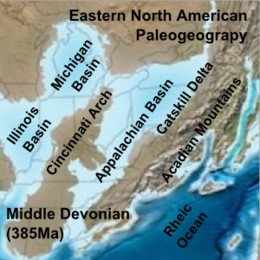
Palaeogeography (or paleogeography) is the study of historical geography, generally physical landscapes.[2] Palaeogeography can also include the study of human or cultural environments. When the focus is specifically on landforms, the term paleogeomorphology is sometimes used instead. Paleomagnetism, paleobiogeography, and tectonic history are among its main tools.
Palaeogeography yields information that is crucial to scientific understanding in a variety of contexts. For example, palaeogeographical analysis of sedimentary basins plays a key role in the field of petroleum geology, because ancient geomorphological environments of the Earth's surface are preserved in the stratigraphic record.[2][3] Palaeogeographers also study the sedimentary environment associated with fossils for clues to the evolutionary development of extinct species.[3] Palaeogeography is furthermore crucial to the understanding of palaeoclimatology, due to the impact of the positions of continents and oceans on influencing global and regional climates.[4]
Palaeogeographical evidence contributed to the development of continental drift theory, and continues to inform current plate tectonic theories, yielding information about the shape and latitudinal location of supercontinents such as Pangaea and ancient oceans such as Panthalassa, thus enabling reconstruction of prehistoric continents and oceans.[5]
YouTube Encyclopedic
-
1/3Views:1 269350689
-
Earth's Palaeogeography From Ediacaran To Quaternary.
-
What Is PALAEOGEOGRAPHY? PALAEOGEOGRAPHY Definition & Meaning
-
APPLICATIONS OF PALAEONTOLOGICAL DATA IN PALAEOECOLOGY AND A BRIEF IDEA OF PALAEOGEOGRAPHY
Transcription
See also
- Paleoclimatology – Study of changes in ancient climate
- Paleoceanography – Study of the oceans in the geologic past
- Paleocontinent – A distinct area of continental crust that existed as a major landmass in the geological past
- Paleoecology – Study of interactions between organisms and their environments across geologic timescales
- Paleogeography of the India–Asia collision system
- Paleohydrology – Study of hydrology over geological time
- Paleontology – Study of life before the Holocene epoch, often involving fossils and pollen (palynology).
- Paleosol – Soil buried under sediment or not representative of current environmental conditions
- Physical geography – Study of processes and patterns in the natural environment
- Plate tectonics – Movement of Earth's lithosphere
References
- ^ Blakey, Ron. "Paleogeography and Geologic Evolution of North America". Global Plate Tectonics and Paleogeography. Northern Arizona University. Archived from the original on 2008-06-21. Retrieved 2008-07-04.
- ^ a b Stanley, Steven M.; Luczaj, John A. (2014). Earth system history (Fourth ed.). New York, NY. ISBN 978-1-4292-5526-4. OCLC 881875780.
{{cite book}}: CS1 maint: location missing publisher (link) - ^ a b Königshof, P. (2009). "Devonian change: case studies in palaeogeography and palaeoecology - an introduction". Geological Society, London, Special Publications. 314 (1): 1–6. Bibcode:2009GSLSP.314....1K. doi:10.1144/SP314.1. ISSN 0305-8719. S2CID 129313287.
- ^ Matthews, Kara J.; Maloney, Kayla T.; Zahirovic, Sabin; Williams, Simon E.; Seton, Maria; Müller, R. Dietmar (November 2016). "Global plate boundary evolution and kinematics since the late Paleozoic". Global and Planetary Change. 146: 226–250. Bibcode:2016GPC...146..226M. doi:10.1016/j.gloplacha.2016.10.002. hdl:2123/20837. S2CID 133473925. Retrieved 26 November 2022.
- ^ Torsvik, Trond H.; L. Robin M. Cocks (2017). Earth history and palaeogeography. Cambridge, United Kingdom. ISBN 978-1-107-10532-4. OCLC 968155663.
{{cite book}}: CS1 maint: location missing publisher (link)
Further reading
- Irving, Edward (February 8, 2005). "The Role of Latitude in Mobilism Debates". PNAS. 102 (6): 1821–1828. Bibcode:2005PNAS..102.1821I. doi:10.1073/pnas.0408162101. PMC 548542. PMID 15684058.
External links
- An interactive tool to visualize paleogeography and reconstruct data (map.paleoenvironment.eu)
- Deep Time Maps


